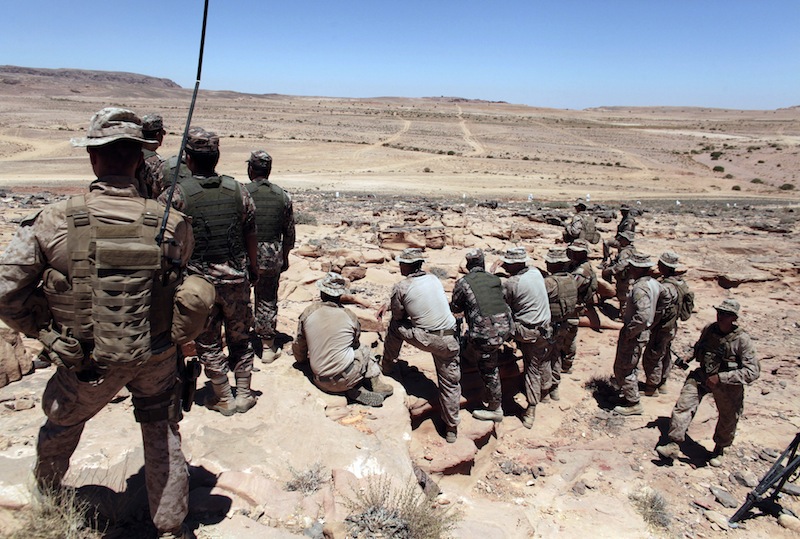WASHINGTON — The Obama administration is considering a plan to use U.S. military trainers to help increase the capabilities of the Syrian rebels, in a move that would greatly expand the current CIA training being done quietly in Jordan, U.S. officials told The Associated Press on Thursday.
Any training would take place outside Syria, and one possible location would be Jordan.
The officials said no decision had been made, but that discussions were going on at high levels of the government. It comes as the Obama administration prods Congress to authorize limited military strikes against Syrian President Bashar Assad’s government in retaliation for a deadly Aug. 21 chemical weapons attack.
The proposal to use the U.S. military to train the rebels — something the administration has resisted through more than two years of civil war — would answer the demands of some lawmakers, including Sen. John McCain, R-Ariz., to do more to train and equip the Syrian opposition. President Barack Obama in June decided to provide lethal aid to the rebels, but so far none of that assistance has gotten to the opposition.
Officials said Thursday that talk about a military training mission has increased but that there have been no specific Pentagon recommendations forwarded to the White House on how big it should be or how many troops it should involve.
The CIA has been training select groups of rebels in Jordan on the use of communications equipment and some weapons provided by Gulf states. The new discussions center on whether the U.S. military should take over the mission so that hundreds or thousands can be trained, rather than just dozens.
The officials spoke on condition of anonymity because they were not authorized to discuss the plan publicly.
Any new training program conducted by the U.S. military would take time to put in place and likely would not begin until after any potential military action had been taken in response to the recent chemical weapons attack. It would require getting approvals from the host country, finding appropriate locations, getting the right number of personnel in place to conduct the training and setting up a vetting system to insure that instruction was not provided to any rebel groups that may not be friendly to the U.S.
The Pentagon already has at least 1,000 troops in Jordan, including trainers working with Jordanian forces. The U.S. left about a dozen fighter jets and a Patriot missile battery there after a recent training exercise.
Gen. Martin Dempsey, chairman of the Joint Chiefs of Staff, has told Congress that the U.S. military would be prepared to do more training for the Syria opposition if needed.
In response to questioning Wednesday during a House Foreign Affairs Committee hearing on Syria, Dempsey said he was “mostly supportive of helping the opposition by their development, by their training and equipping, not by becoming their military arm.”
He provided more details in a July letter to Sen. Carl Levin, D-Mich., the chairman of the Senate Armed Services, in which he laid out military options in response to the chemical weapons attack. That letter was sent before Obama announced plans to go to Congress to seek authorization for military strikes in Syria that would be limited in time and scope and would involve no U.S. troops on the ground there.
He said the U.S. could provide between several hundred and several thousand trainers, with a cost of as much as $500 million a year, depending on how large the training mission became. Noting that it would require using “safe areas” outside Syria, he said the risks included “extremists gaining access to additional capabilities, retaliatory cross-border attacks, and insider attacks or inadvertent association with war crimes due to vetting difficulties.”
In hearings this week, some members of Congress complained that the Obama administration has not done enough for the rebels, while others strongly opposed any American military involvement in Syria. Lawmakers warned Dempsey and Defense Secretary Chuck Hagel that Americans are weary of war and are not willing to spend more money and risk more lives.
U.S. officials continue to say that any likely military action would be limited and bear no resemblance to the wars in Iraq and Afghanistan, or even the short military operation in Libya in 2010. Instead, it would center on cruise missiles fired from U.S. ships — including submarines — in the Mediterranean Sea.
There also is no enthusiasm for sending U.S. pilots into Syrian airspace. If additional military assets are needed in order to strike a larger number of targets inside Syria, the U.S. could use long-range bombers, which could fire missiles without crossing into the country’s airspace.
France also has a dozen cruise missile-capable fighter aircraft at military bases in the United Arab Emirates and the Horn of Africa nation of Djibouti.
Send questions/comments to the editors.



Success. Please wait for the page to reload. If the page does not reload within 5 seconds, please refresh the page.
Enter your email and password to access comments.
Hi, to comment on stories you must . This profile is in addition to your subscription and website login.
Already have a commenting profile? .
Invalid username/password.
Please check your email to confirm and complete your registration.
Only subscribers are eligible to post comments. Please subscribe or login first for digital access. Here’s why.
Use the form below to reset your password. When you've submitted your account email, we will send an email with a reset code.